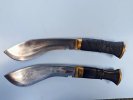el gigantor
Gold Member
- Joined
- Oct 5, 2015
- Messages
- 2,018
Just wondering if any of you folks who spend some time in the woods camping and doing bushcraft stuff ever bring a kukri along for the ride. The fellow who won season 1 of Alone was rocking one for his primary cutting tool and while at first it caught me off guard, he seemed to make it work quite well.
I've already got a fleet of fixed blades but the more I think about the curvature of that kukri, the more I dig it. I'd love to get some input from those with hands on experience. Cheers!
I've already got a fleet of fixed blades but the more I think about the curvature of that kukri, the more I dig it. I'd love to get some input from those with hands on experience. Cheers!






